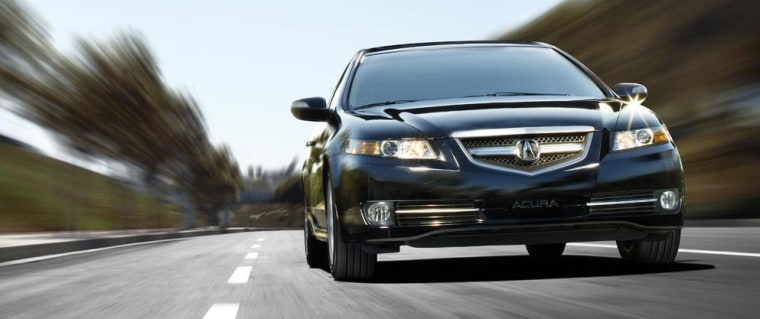Having something break on a nearly new car could lead you to love it more.
Lexus IS250 owners can attest to that. Lexus' dealerships offer some of the industry's best perks (in-showroom cappuccino machines, among them) and the brand's service department is known to work overtime for customers. Lexus is just one of several luxury brands offering over-the-top dealership service that separates their vehicles from the rest — and instills buyer loyalty and satisfaction.
"If you have one minor problem that's taken care of immediately," says Alexander Edwards, automotive division president of the market research firm Strategic Vision, "you'll perceive your vehicle to be of a higher quality than if you'd had zero problems."
This eyebrow-raising discovery illustrates an important point: In the luxury realm, if the car isn't perfect, other aspects need to be. That's because luxury-car buyers are purchasing more than the car itself.
"Time cost is what's becoming the biggest factor," says Milton Pedraza, CEO of the Luxury Institute, a market research firm focusing on affluent consumers. Buyers are asking, "How easy is it to own this car?"
The answer lies in key metrics that measure a luxury car's value, including price, consumer satisfaction, reliability, maintenance and fuel costs.
Behind The Numbers
In compiling our list of the luxury cars that deliver the most return on investment, we first looked at cost. Considering that today's median new-vehicle transaction price hovers around $27,000, and the base price of many "entry luxury" sedans, such as the Mercedes-Benz C-Class and Infiniti G35, is set just above the $30,000 mark, we included all passenger cars and SUVs with starting prices, including destination, over $30,000.
Then, respecting the point that dealership service especially matters to luxury buyers, we considered the 2007 results of J.D. Power and Associates' annual Customer Service Index (CSI) scores, which assess satisfaction with dealership service in the first three years of ownership. Any brands that performed below the industry average (876 on the index's 1,000-point scale) were then removed from consideration. Among luxury brands, this included Mercedes-Benz, at 872, along with Land Rover, which ranked near the bottom, at 843.
Next, we looked to Strategic Vision's 2007 Total Value Index (TVI) scores, which assess one's complete ownership experience, including reliability and dealership experience, on a weighted scale, out of a possible 1,000 points.
In considering these, we removed any vehicles from our list that didn't achieve above-average scores in their respective segments (the firm has 20 of them, covering specific types of vehicles, such as "Convertible Over $30,000" and "Luxury Car").
Finally, we looked at overall five-year ownership costs, as compiled for 2008 models (2007 costs were used when necessary in a few cases) by Vincentric, a data analysis firm providing cost-of-ownership information to the auto industry. We used Vincentric's average costs across each model line, as ownership costs might vary depending on equipment, options, and trim levels.
Joining the Lexus IS250 at the top of our list were the Volvo V70 and Acura TL. Each offer luxury amenities, such as supple leather seating and eye-catching trims, along with more modern features, like sophisticated navigation systems, voice-activated features, or advanced safety devices like the Volvo's "blind spot information system." All also cost well below $40,000, even when a few major options are added.
That's important — because most luxury car shoppers aren't eager to spend more money than they need to. But there's an exception, Edwards says. Luxury-vehicle shoppers will be willing to pay for some items that might be called "functional luxury," such as automatic wipers or "smart" cruise control systems — features that readily redeem themselves. It's when luxury features don't enhance functionality and buyers are already ponying up for the brand experience that customers are more conscious of that extra money, because it adds cost but not value, he says.
A buyer must also consider depreciation, insurance premiums, fuel expenses, maintenance and repair — all aspects included in Vincentric's ownership costs, which vary greatly from model to model. For instance, the five-year estimate for the $11,300 Yaris stands at $31,250, while the ownership costs top $150,000 for several of the most expensive models from Mercedes-Benz and BMW, which ring in at sticker prices of over $100,000.
David Wurster, Vincentric's president, says that because luxury cars are considerably more expensive than more mainstream models, shoppers should be especially concerned with depreciation, which isn't always tied to sticker price. Using 2007-model-year data, for example, a $34,300 BMW 328xi, which is priced just below the $35,060 Jaguar X-Type sedan when new, is estimated to be worth over $3,000 more than the Jaguar after five years.
Another thing to consider is gas mileage, Wurster says, as luxury cars tend to use more fuel.
You're on the right track if you want to keep maintenance costs down, too. But with fuel prices and insurance premiums especially contributing to ownership costs (which have risen faster than the sticker prices of the cars themselves), Wurster says maintenance costs are the exception. Because automakers have been extending the time and mileage between oil changes and other service visits, he explains, it's no longer the value differentiator it once was, and a smaller piece of the pie (the pie of long-term ownership costs, that is) than it used to be.
Perhaps the least tangible measure of value is a luxury automaker's reputation. Luxury-car buyers are becoming increasingly interested in cars from automakers that demonstrate a high level of environmental responsibility.
The environment, along with philanthropy and labor and trade policies, says Pedraza, are rapidly growing factors that lead well-informed luxury shoppers to look to a certain brand as greener luxury for the buck, even if the costs of the eco-friendly brand and its model add up to a bit more, he says.
Which again goes to show that the value of a car can be much greater than its cost.
